|
PLASTIGLOMERATES
PLEASE USE OUR A-Z INDEX
TO NAVIGATE THIS SITE
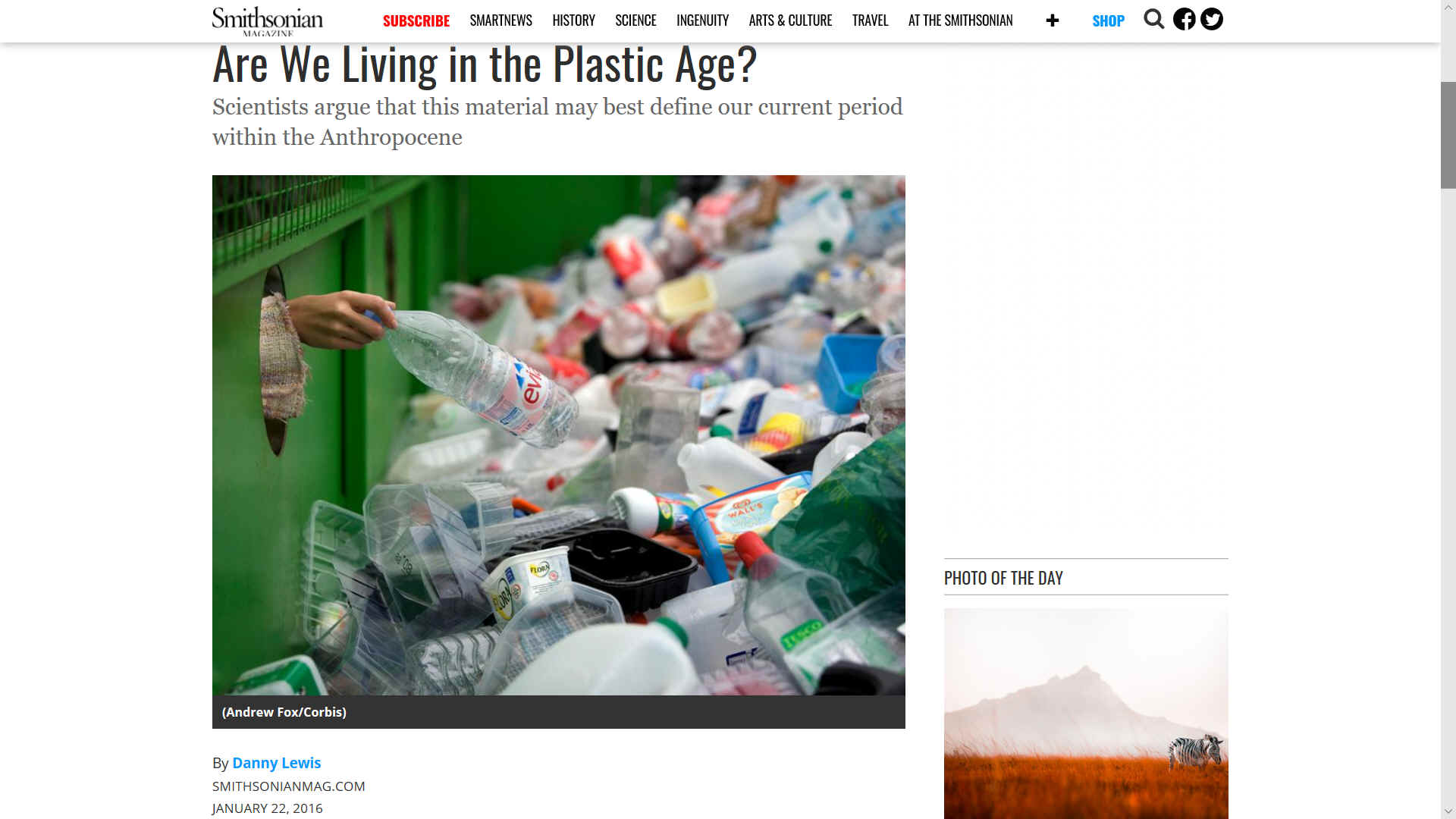
HUFFINGTON POST - ENVIRONMENT
JUNE 2014 (Updated Dec 06, 2017 ) Plastiglomerate: The New And Horrible Way Humans Are Leaving Their Mark On The Planet
Humans will now be forever inscribed into the Earth’s geological history. Our everlasting signature? Plastic-infused stones.
The newly identified stone, according to a report from The Geological Society of America, has been officially named plastiglomerate. It is formed when plastic trash melts and fuses together with natural materials such as basaltic lava fragments, sand, shells, wood and coral, resulting in a plastic-rock hybrid.
Researchers say the new material is likely to last a very long time, possibly becoming a permanent marker in Earth’s geologic record.
“In the future, when people see [plastiglomerate] in the rock record, they’ll be able to know, ‘Well, OK, people at this time were polluting the planet [with plastics]. What a travesty that these people were doing that,’ “ Patricia Corcoran, a geologist at the University of Western Ontario and study lead author, told The Huffington Post.
“Now that could be one side of the coin,” she explained. “The other is that people continue to do this and it’ll just become the norm to have this type of material preserved for all eternity.”
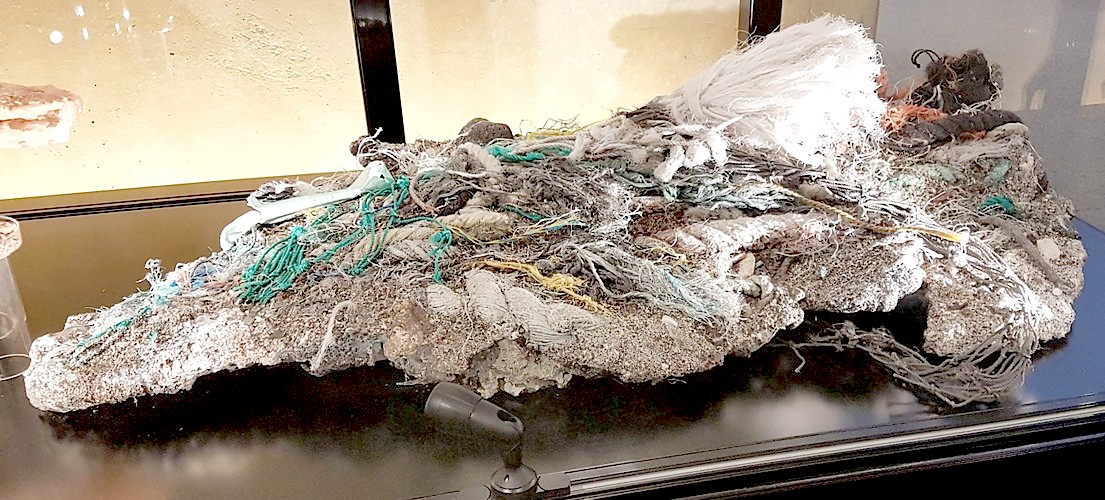
The material at the heart of the debate is plastiglomerate – a composite formed of natural debris and sedimentary grains, and held together by molten plastic. The term itself was proposed by Moore, geologist Patricia Corcoran and artist Kelly Jazvac in an attempt to give this new evolution a name.
Plastiglomerates were first noticed by Moore in 2006, when he was surveying plastic washed up on Hawaii’s Kamilo Beach, one of the American state’s most polluted coastal areas. It wasn’t until 2012, though, that the collection and analysis of samples was
formalised, with the additional help of Corcoran. As part of their fieldwork, a total of 205 specimens were foraged from 21 sites on a 2,300-foot wide strip, and ranged from the size of a peach pit to that of a large pizza.
Although, at one time, it was suggested that these bundles of solid matter might have been the result of heat generated by the volcanic island’s innumerable lava flows, human campfires were soon identified as the primary factor in their creation.
This discovery, as the New York Times reports, might be another indication that Earth has “entered a new geological era“ referred to as the
Anthropocene epoch — the period of time wherein humans began to leave significant and lasting impacts on the planet’s landscape and atmosphere. Earth is currently in the Holocene epoch, which began almost 12,000 years ago.
Corcoran and her team traveled to Hawaii to observe the new substance after learning about it from sea captain and oceanographer
Charles
Moore [Algalita], who discovered cases of plastiglomerate on Kamilo Beach on Hawaii’s Big Island in 2006.
Kamilo Beach, also considered one of the world’s dirtiest beaches, became the perfect spot to observe this new substance because of how the ocean’s currents push garbage, plastic debris and other ocean pollutants onto its shores, as it does in other beaches on the southeastern shores of the Hawaiian Islands.
Researchers first assumed that the melted plastic was a result from possible flowing lava from Hawaii’s active volcano, but discovered their samples were a result of beachside campfires that took place within their surveyed area. They point out in their report that while campfires were “responsible for the plastiglomerate on Kamilo Beach, it is conceivable that the global extent of plastic debris could lead to similar deposits where lava flows, forest fires, and extreme temperatures occur.”
While surveying Kamilo Beach, Corcoran and her team found plastic debris with markings that indicate they have traveled all the way from places like Asia and Russia. A lot of that debris, Corcoran said, is coming from the North Pacific Subtropical Gyre, also known as the Great Pacific Garbage Patch.
But plastiglomerate is likely to exist across the globe.
“We find plastic debris — and an abundance of it — on many shorelines in places like India, Africa, even on the shoreline of Iceland,” Corcoran said. “Plastic is everywhere,” and inevitably, it will become melded with beach sediment.
So, what can we do to permanently reverse the damage we’ve done with plastic pollution? Corcoran said every country on the
planet would have to suddenly agree to never use plastics again, which, she notes, is extremely unlikely.
But “we can all pitch in and help through beach cleanups and not using as many plastic products,” she insisted. “Maybe by raising awareness [of how serious the problem is], people will start to say, ‘OK, that’s kind of disgusting so maybe ... I should think twice before I buy a bunch of balloons or use a straw. Even small things make a difference.”
By Carla Herreria
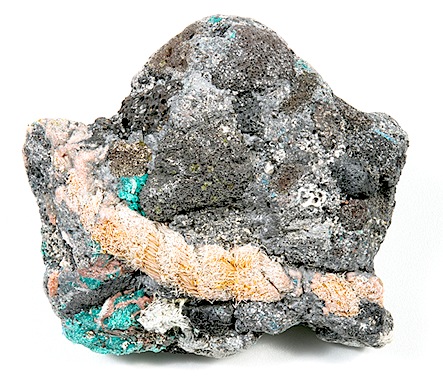
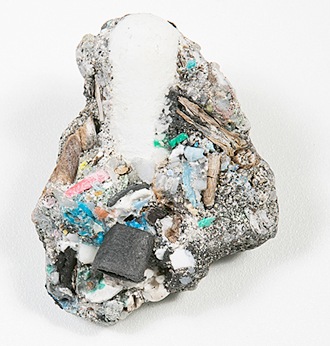
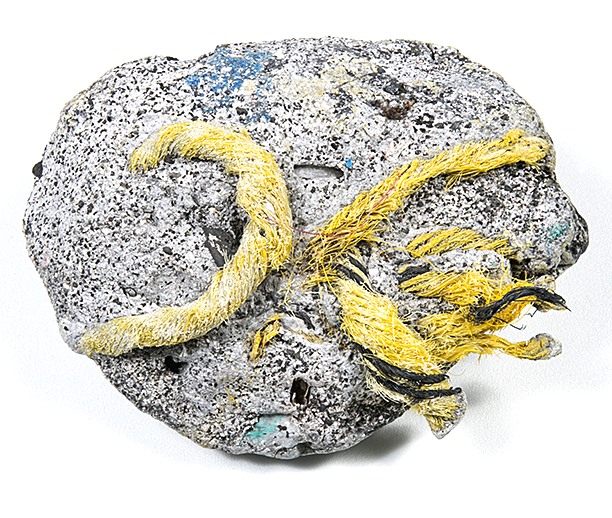
SCIENCE MAGAZINE - Rocks Made of Plastic Found on Hawaiian Beach JUNE 2014
Plastic may be with us a lot longer than we thought. In addition to clogging up landfills and becoming trapped in Arctic ice, some of it is turning into stone. Scientists say a new type of rock cobbled together from plastic, volcanic rock, beach sand, seashells, and
corals has begun forming on the shores of Hawaii.
“The article is intriguing and fascinating,” says geophysicist Douglas Jerolmack of the University of Pennsylvania, who was not involved in the work. “If these things can be preserved, then they might be a nice marker around the world of when humans came to dominate the globe and leave behind their refuse in mass quantities.”
Geologist Patricia Corcoran of the University of Western Ontario in London,
Canada, and Charles Moore, captain of the oceanographic research vessel Alguita, stumbled upon the new rocks on a beach on the Big Island of Hawaii. These stones, which they’ve dubbed “plastiglomerates,” most likely formed from melting plastic in fires lit by humans who were camping or fishing, the team reports this month in GSA Today. Although anywhere there is a heat source, such as forest fires or lava flows, and “abundant plastic debris,” Corcoran says, “there is the potential for the formation of plastiglomerate.” When the plastic melts, it cements rock fragments, sand, and shell debris together, or the plastic can flow into larger rocks and fill in cracks and bubbles to form a kind of junkyard Frankenstein.
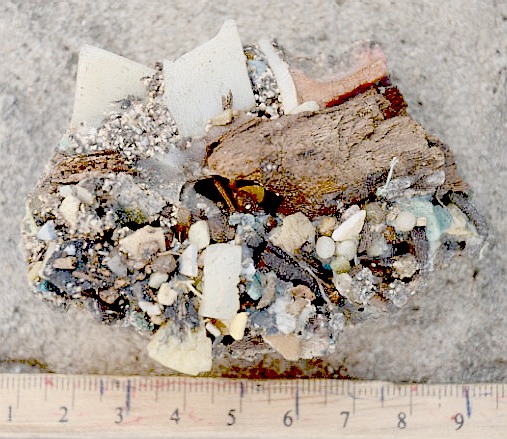
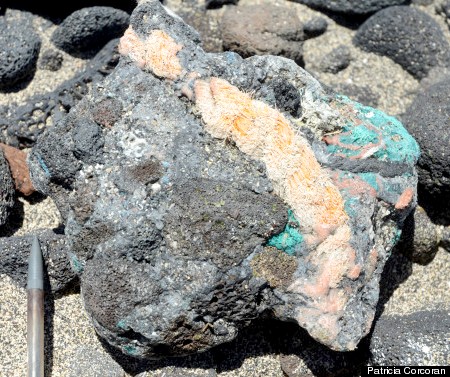
Corcoran says some of the plastic is still recognizable as toothbrushes, forks,
ropes, and just “anything you can think of.” Once the plastic has fused to denser materials, like rock and coral, it sinks to the sea floor, and the chances it will become buried and preserved in the geologic record increase.
Corcoran and her team canvassed Kamilo Beach on the Big Island for more of the rocks and found plastiglomerate in all 21 sites they surveyed. She says people have already found plastiglomerate on another Hawaiian island, and she expects there to be much more on coastlines across the world. Plastiglomerate is likely well distributed, it’s just never been noticed before now, she says.
Jerolmack agrees. “All around the world where there’s trash being openly burned in mass quantities, you can imagine there are even larger melted plastic deposits” where plastiglomerate could form.
The discovery adds to the debate about whether humanity’s heavy hand in natural processes warrants the formal declaration of a new epoch of Earth history, the Anthropocene, says paleontologist Jan Zalasiewicz of the University of Leicester in the
United
Kingdom, who was not involved in the study. Plastics in general are so pervasive that they’ve been documented in a number of surprising places, including ingested in wildlife and on the sea floor. The mass of plastic produced since 1950 is close to 6 billion metric tons, enough to bundle the entire planet in plastic wrap. Combine plastic’s abundance with its persistence in the environment, and there’s a good chance it’ll get into the fossil record, Zalasiewicz says. “Plastics, including plastiglomerates, would be one of the key markers by which people could recognize the beginning of the
Anthropocene.”
How long the plastic will endure remains a matter of debate, however. Jerolmack says he doubts the material will stick around in the fossil record. After all,
plastic melts, and rocks often pass through hellish depths and temperatures through tectonic processes and burial. Geologist Philip Gibbard of the University of Cambridge in the United Kingdom says he imagines that plastics might “revert back to a source of oil from whence they came, given the right conditions of burial.” But Zalasiewicz and Corcoran say that isn’t true for all the plastic. Some of the material can be preserved as a thin carbon film, much like the way fossil leaves are preserved. Zalasiewicz says that in some rare cases, in that etch of carbon “you may well be left the shape for a flattened plastic bottle.”
By Angus ChenJun
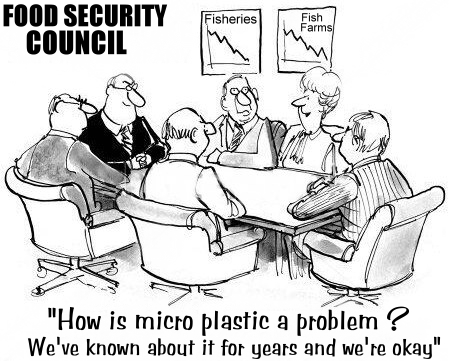
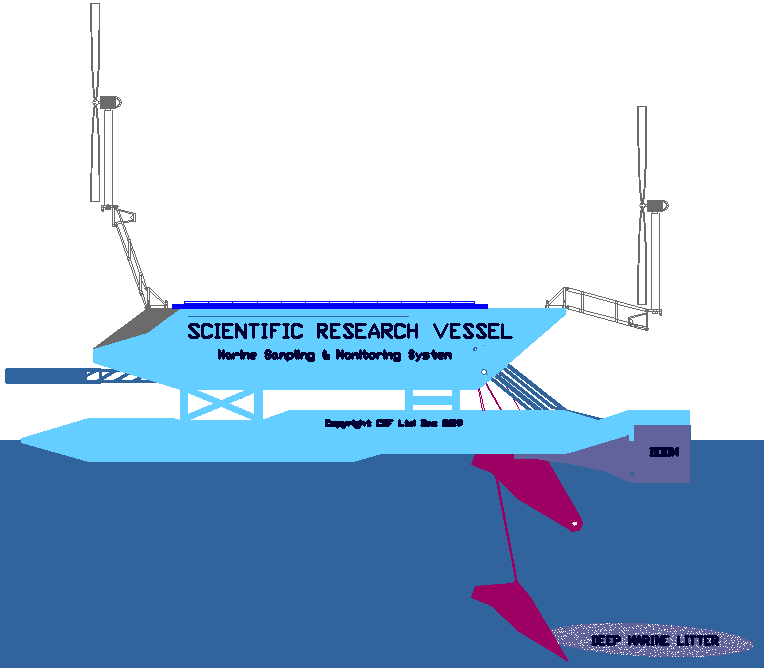
Plastiglomerate is a term that was proposed by Patricia Corcoran, Charles J. Moore and Kelly Jazvac for a stone that contains mixtures of sedimentary grains, and other natural debris (e.g. shells, wood) that is held together by hardened molten plastic. It has been considered a potential marker of the
Anthropocene, an informal epoch of the Quaternary proposed by some social scientists, environmentalists, and geologists.
Plastiglomerates form along shorelines where natural sedimentary grains and organic debris are agglutinated by melted plastic created during campfire burning. They have been reported from Kamilo Beach on the island of Hawaii.
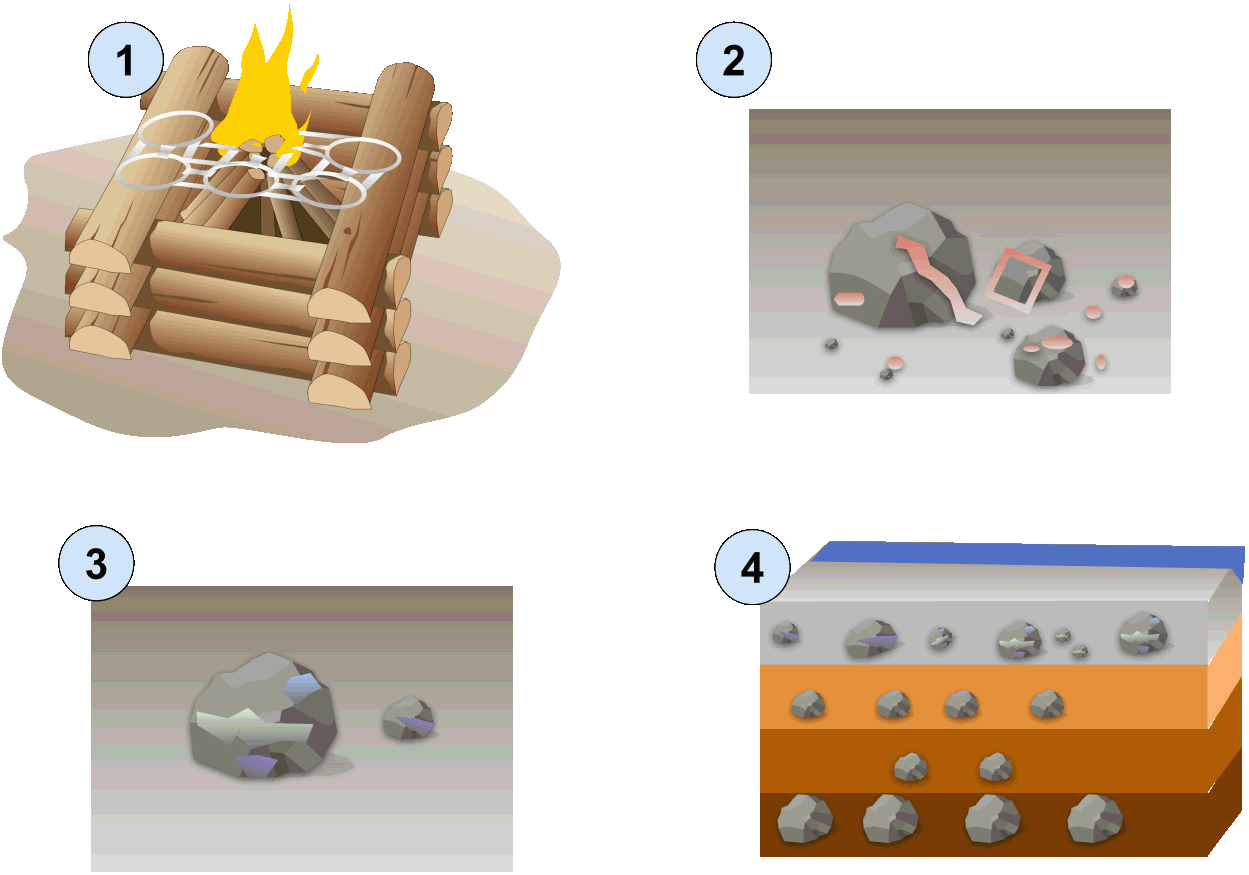
The melting of plastic waste from campfires or high temperatures on beaches(1)is resulting in the formation of a new type of rock known as plastiglomerate (2). Formed plastiglomerate merges with surrounding sediment to create a compositionally different sediment layer(3).The emergence of this new layer is being used as physical evidence of a marker horizon for an Anthropocene Epoch(4).
HUMAN
ENVIRONMENTAL MARKER - ANTHROPOCENE
Plastiglomerate could potentially form a marker horizon of human pollution on the geologic record. and may survive as future fossils. Plastiglomerate may also conceivably form in plastic-polluted regions affected by lava flows or forest fires. They have been found on the surface as well as beneath the sand. This suggests that plastiglomerates are being actively deposited into the sedimentary record. Some geophysicists and geologists speculate that plastiglomerates will not persist in the fossil record, however, or that they might "revert back to a source of oil from whence they came, given the right conditions of burial".
"In situ" plastiglomerate forms where plastic melts and fills in rock cavities. "Clastic" plastiglomerate are smaller solitary pieces that form where larger fused items become fragmented by waves. Plastiglomerate is more dense than particles that are solely composed of plastic, which gives them greater potential to become buried and preserved in the rock record.
Plastiglomerate from Kamilo Beach displayed in the exhibition One Planet in Museon (The Hague, The Netherlands).
Plastiglomerates have been featured at the Yale Peabody Museum of Natural History; Oakville Galleries in Oakville, Ontario, Canada; Louis B. James Gallery in New York City; Carleton University Gallery in Ottawa, Ontario, Canada; Prosjektrom Normanns, Stavanger, Norway; and Museon in The Hague, Netherlands. Museon has probably the largest piece in its possession, as it is more than 1m long and 50 cm wide.
The huge abundance of plastic waste that surrounds us has been well documented. According to oceanographer Charles J. Moore, writing in The New York Times:
“No scientist, environmentalist, entrepreneur, national or international government agency has yet been able to establish a comprehensive way of recycling the plastic trash that covers our land and inevitably blows and washes down to the sea.”
The lack of credible alternatives to simply dumping our discarded plastic into the ocean means that the pollutant is now playing a role in shaping the future of our geology – the very ground on which we walk. It marks a turning point in the relationship between the human race and planet earth, the beginning of what has been termed the Anthropocene – the epoch in which human activity will start to exert a major influence on Earth’s geology and ecosystems.
Perhaps plastiglomerates could become the next stone, paper, ceramics, marble or granite, and in turn halt the production of new of oil-rich plastics. In that sense, our willingness to harness plastiglomerates could potentially follow in the footsteps of other recycling initiatives, such as Precious Plastics, adidas and Parley’s plastic from the ocean shoes and Studio Swine’s Gyrecraft collection.
According to Richard Thompson, a marine biologist at
Plymouth University who was involved in the research:
“Most conventional plastic is relatively thin and fragments quickly, but what’s being described here is something that’s going to be even more resistant to the ageing process.”
Could these new formations survive as our future fossils, as a record of our time here on earth? If these geological findings were buried within the rock strata, could they stand the test of time for millions of years?
HISTORY
Charles Moore, a sea captain and oceanographer for the Algalita Marine Research Institute in Long Beach, California, discovered this substance in 2006 while surveying Kamilo Beach on the Big Island of Hawai’i. Geology professor, Dr. Patricia Corcoran and Visual artist professor, Kelly Jazvac of the University of Western Ontario investigated the samples on Kamilo Beach in 2012 where they also coined the term "plastiglomerate". Approximately one-fifth of the plastiglomerates found at Kamilo Beach consisted of fishing debris, one quarter consisted of broken lid containers, and one half consisted of plastic "confetti". The plastiglomerate at Kamilo Beach was more likely created from
human campfires than from molten lava flows.
LINKS
& REFERENCE
http://www.studioswine.com/gyrecraft
http://preciousplastic.com/en/
http://www.kellyjazvac.com/Stones/Stones.html
http://www.uwo.ca/earth/people/faculty/corcoran.html
http://www.nytimes.com/2014/08/26/opinion/choking-the-oceans-with-plastic.html?smid=tw-share&_r=1
http://nirvanacph.com/2016/10/material-monday-plastiglomerates/
https://en.wikipedia.org/wiki/Plastiglomerate
http://www.andyhughes.net/site/portfolio-2/uncategorized/plastiglomerate/
https://www.sciencemag.org/news/2014/06/rocks-made-plastic-found-hawaiian-beach
https://www.huffpost.com/entry/plastiglomerate_n_5496062
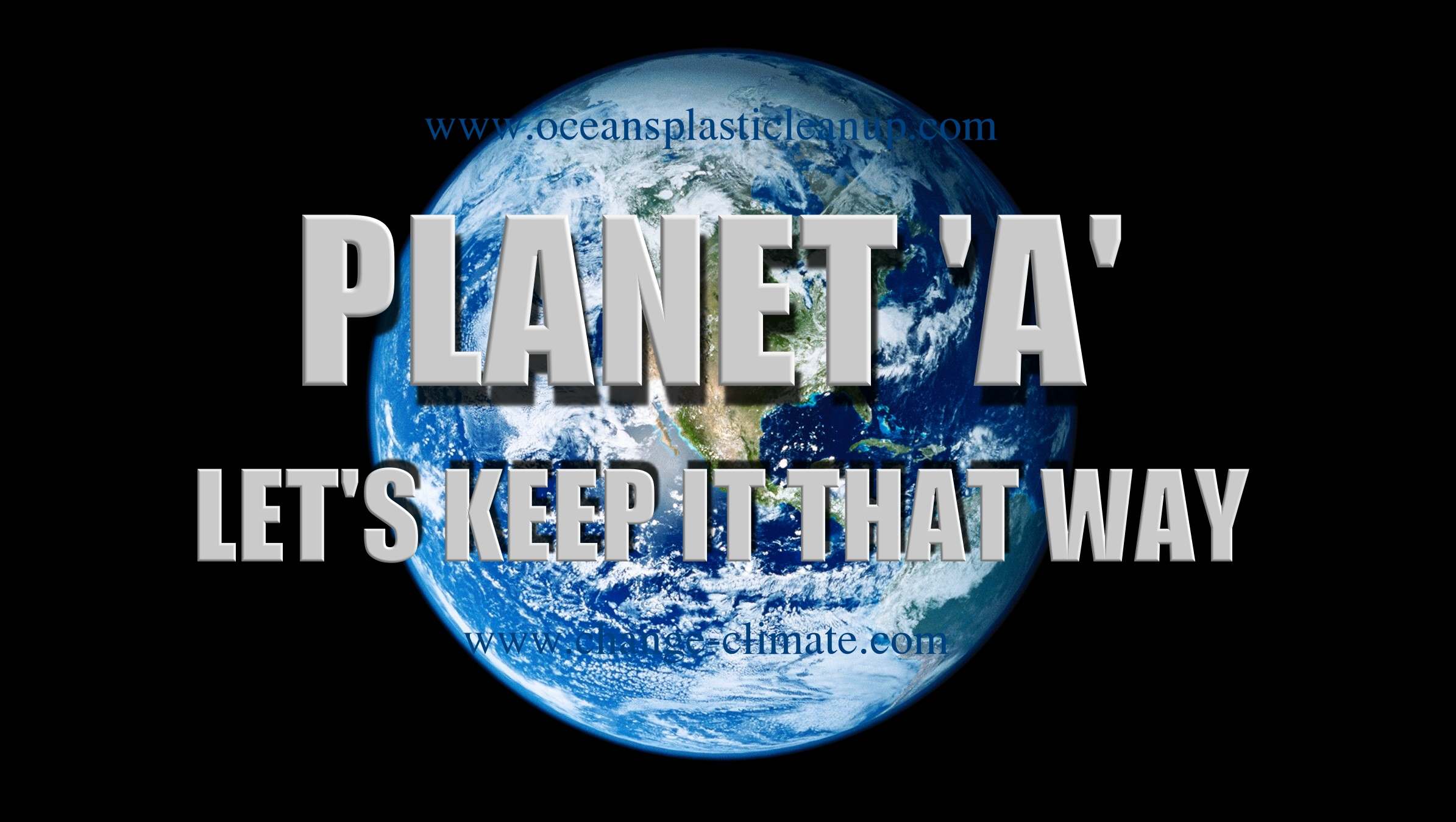
ARE
PLANET
EARTH'S POLICIES WORKING? - If
they were, we'd not have plastic poisoning the marine
environment, or global
warming. The problem is world leaders rely too much
on fossil fuels and do not want to rock the boat until there
is a solid backup plan, but the backup plan involves change.
And that frightens them to stay put even though the water is
already bubbling.
We cotton to
that. Nobody likes change. But instead of
overheating the planet and killing life undersea with toxic plastic, surely
it would make sense to brave the new world and accelerate the adoption of
renewables and a society that cleans up after itself. We need
new sustainable infrastructures to save PLANET A and a gradual
changeover plan that sits well with stakeholders. Not to have
the infrastructures ready is suicide politics - the way of the
Dodo.
ABS
- BIOMAGNIFICATION
- CANCER
- CARRIER
BAGS - COTTON
BUDS - DDT
- FISHING
NETS
HEAVY
METALS - MARINE
LITTER - MICROBEADS
- MICRO
PLASTICS - NYLON
- OCEAN
GYRES - OCEAN
WASTE
PACKAGING
- PCBS
- PET
- PLASTIC
- PLASTICS
- POLYCARBONATE
- POLYETHYLENE
- POLYSTYRENE
- POLYPROPYLENE
POLYTHENE
- POPS
- PVC
- SHOES
- SINGLE
USE - SOUP
- STRAWS
- WATER
This website is
provided on a free basis as a public information service. copyright © Cleaner
Oceans Foundation Ltd (COFL) (Company
No: 4674774) 2020.
Solar
Studios, BN271RF, United Kingdom.
COFL is
a company without share capital.
|








